1.4 实验方法 实验路线见
图1。
.jpg)
1.4.1 构建髋骨三维模型 Mimics软件是Materialise公司旗下的医学工程软件[5],Mimics是一个衔接二维图像数据(CT,工业扫描数据)和三维模型的图像处理工具,应用领域包括:解剖测量、三维分析、有限元分析、定制假体或设备设计、新型制造(3D打印)及手术计划和模拟。另外,Mimics是Mimics Innovation Suite的一部分,这一套装也包括了3-matic®。其中,Mimics被用来生成精确的3D模型,3-matic被用来在解剖学模型的基础上进行设计和网格操作。因此,3-matic极大程度地扩展了Mimics在医学数据的应用可能性。
相较于传统的PS或AutoCAD软件,Mimics不采用将CT片直接导入的方法[6],相反,它直接读取CT图像原始数据建模,并且根据自己的功能进行绘制和优化模型。Mimics不仅支持Dicom格式数据,而且能够直接导入扫描原始数据,这些数据可通过硬盘、光盘或磁盘导入。Mimics也支持BMP、JPEG及TIFF格式文件的导入。源文件可通过在New project wizard的第一步,选择“file name”的方式手动导入,见图2。
.jpg)
浏览到CT所在的文件夹,选择点击Next,(C\MedData\)文件夹固定,Mimics会直接读取 DICOM 图像所带有的标签,自动创建一个Mimics项目文件,点击Convert完成转化。它的优势在于不用预先导入其他CT分析软件进行预处理,比如GE Lung VCAR软件分析,Mimics的建模方法更简单、更快捷,避免了重复操作对数据和信息丢失的影响。
通过Masks界面点击Green,右键创建NewMask,采集226和2 233灰度值,用于生成人体髋部三维模型,见图3,4。再通过Calculate 3D界面创建,Quality选择Optional创建三视图界面。
.jpg)
通过Edit mask in 3D界面,使用Remove命令来切除多余的骨骼模型,生成了骨骼网,使用3-Matic Mimics模块Cut Orthogonal to Screen(Not Responding)用于生成后臀部的体积模型,在3-Matic软件中切割髋骨和骶骨部分后,分离出髋骨。
图5-7显示了髋骨三维模型,从原始的CT数据导入到Mimics中,通过建立模型、图像定位、阀值分割、动态分割,每层图像经选择性的编辑和补洞处理,去除多余的数据,删除多余模型和多余的残缺模型,经过多次删除和修复,分离出完美的髋骨模型,然后建立3D实体模型。最后以.stl格式导出,以便接下来的曲面拟合、网格划分和受力分析。
.jpg)
基于CT扫描获得的DICOM数据三维重建,是一种非常成熟的方法。因此,使用Mimics软件可用于构建髋骨三维几何模型,该模型用于术前测量、术前设计和手术模拟,可稳定提高手术效率和准确性。
1.4.2 有限元的前处理
髋骨模型修复:Geomagic是世界领先的软件和服务公司,在汽车、航空航天、医疗设备、消费品等行业得到广泛应用,公司的主要产品有Geomagic Studio、Geomagic Qualify、Geomagic Piano。此次研究所使用的主要是Geomagic Studio软件,Geomagic Studio是一种广泛使用的逆向工程软件,可帮助用户从点云数据创建优化的多边形网格、曲面或CAD模型。
之前的三维模型图像以.stl格式导入Geomagic中[5],输入选项设置,以便程序可通过检测输入的骨面自动给出提示。表面网格优化过程多次减少网格数量,以提高网格质量和质量准确性。通过自相交测试,找到少量质量较差的三角形,如图8,并同时将其手动标记、删除、更改、合并等,以便最终满足要求。
.jpg)
通过表面装填、缝合和封闭操作,精确曲面、自动曲面化、构造曲面片、构造格栅,如图9所示,最后拟合曲面来进行曲面的光滑处理,完成三角面片的处理。在曲面阶段构建NURBS曲面片,之后完成髋骨模型的实体化,输出为.Step的文件。
.jpg)
髋骨曲面拟合:如果直接进行有限元划分,会产生自相交的情况,无法进行后续的体网格划分,因此必须将曲面修复成规则曲面,还需要减小三角形,以减少原始三角形的数量,并且将不规则图案变换为接近等边三角形的规则图案,然后将所有的三角形面片拟合成整个曲面[5],如图10所示。
.jpg)
表面网格优化是最重要和最困难的。同时,由于它是有限元分析过程中重要的一步[6],为了后续分析可顺利进行,必须要提高计算精度,所以需要提高曲面网格的质量。通过控制质量参数(控制单元长度、重复次数、角度等)可完成专业的自动重绘,ABAQUS软件的自动网格划分功能,可优化髋骨有限元网格。
1.4.3 逆向动力学分析
创建骨骼模型:肌肉骨骼模型是研究关节力学的常用方法[7],患者特异性适应的肌肉骨骼模型,提供了接近个体髋关节的力[8]。目前,肌肉骨骼模型从实施到术前计划的过程仍然是困难的,因为除其他原因外,肌肉骨骼模型的验证是一项艰巨的任务[9-10]。Hicks等[11]报道了患者特异性髋关节置换计划框架内使用肌肉骨骼模型的情况,但没有提供有关其专有肌肉骨骼模型验证的信息。为了验证骨骼模型的使用效果,将骨骼模型模拟结果与同一受试者的实验体内数据进行了比较。首先验证下半身骨骼模型的数据,以便在髋关节置换中进行术前准备,通过Anybody软件建立人体肌肉骨骼模型,见图11。Anybody是一种人体骨骼模拟软件,可在不同的肌肉标准之间进行选择,以解决众所周知的肌肉冗余问题,还可使用不同的骨骼模型来模拟不同负荷条件下的骨骼和肌肉受力效果。
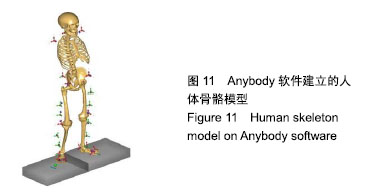
模型下半身MoCap-Model由躯干和腿组成,头部、胸部和腰椎是躯干的一部分,头部通过具有一个自由度的旋转关节连接到胸腔。对于CT-HJW,设定90 N/cm2肌肉力量。运行Anybody步态逆向动力学分析,加载髋骨周围的肌肉力量,并根据时间的变化调整每个肌肉的强度,同时可在分析软件上获得不同时间步长的应力和应变结果[2],见图12,13。
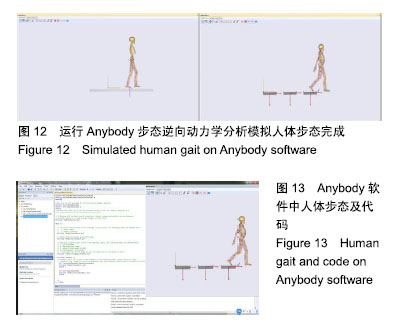
动力学分析:研究生物力学,要了解关节反应力、关节力矩(由肌肉产生)和肌肉激活程度,“SelectedOutput”文件夹中提供了这些值,如图14。通过Anybody的人体模拟动力学分析,得出髋部骨骼的具体受力数据如图15。图15中髋骨的3个力数据均呈现上升趋势,Hip_ProximoDistalForce远端力上升趋势最高,1 s内达到了1 500 N左右,并且3个力(垂直轴内侧力、矢状轴远端力、冠状轴前后力)的数据都有着继续上升的趋势,需要着重于髋骨承受远端力的地方。
图16中在1.6 s时,髋骨受力逐渐变大,在2.1 s时,矢状轴远端力Hip_ProximoDistalForce方向力达到最大值,为1 900 N;在2.9 s时,冠状轴前后力Hip_Antero PosteriorForce方向力达到最大值,为300 N;同时垂直轴内侧力Hip_MediolateralForce也达到了最大值,为800 N。
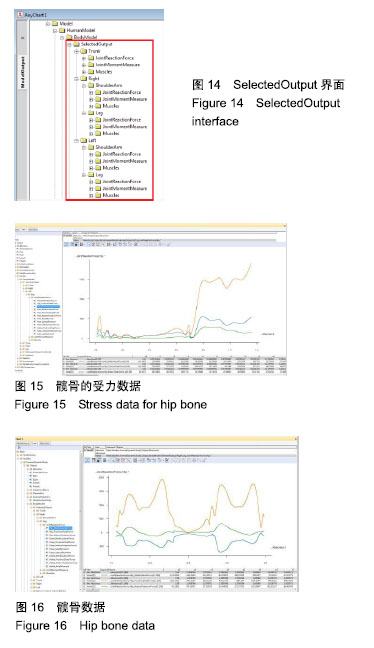
髋关节力在3个方向上具有一定的线性关系,逆动力学分析结果是在某一时刻达到最大值,在下一时刻达到最小值,同时最大值和最小值具有恒定的周期性[2]。人体的行走状态具有来回往复的周期性循环,分析结果符合人体的正常受力状态。
Anybody模拟分析在骨骼受力方面具有很大的优势。通过模型计算获得了正常步行周期中下肢髋关节骨的髋骨内侧力、远端力及前后力参数,并获得了更接近实际情况的人体生物力学参数。患者水平行走,髋关节中的最高受力发生在远端位置[3]。
1.4.4 有限元分析 见图17。
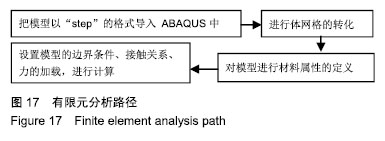
有限元分析前处理:将髋骨拟合模型.step格式导入到ABAQUS中,进行网格的划分运算,见图18。首先导入ABAQUS软件中,通过网格命令进行体网格的转化[12],指派网格控制属性的单元形状为四边形,选择自由划分,选择为部件划分网格按钮,选着整个模型转化为四面体单元后[8],通过界面的结果全局种子指派完成四面体单元创建,这时可对模型赋予材料属性。单侧髋骨有限元模型包含92 201个单元,135 659个节点,一种单元,两种材料属性,单体网格形状规则,整体分布合理,密度合适,网格质量合格。
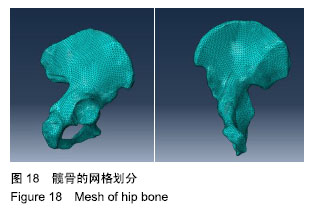
将髋骨材料特性设定为:连续、均质、各向同性的线弹性材料。疏松的骨组织被称为骨松质或松质骨,骨细胞结构密硬的骨组织被称为骨皮质或皮质骨,因此对模型定义两种杨氏模量,皮质骨: E=1.0×107 Pa,泊松比0.3;松质骨:E=0.8×106 Pa,泊松比0.2[13]。接下来对模型施加载荷和约束,如图19,施加载荷大小为5 000 N,约束固定在髋骨和骶骨交界处。文中加载的是压强,把数值输入到ABAQUS中。
1.5 主要观察指标 有限元分析结果。
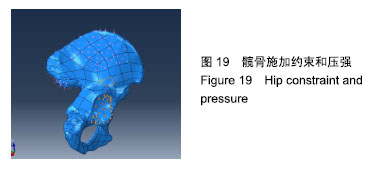
.jpg) 文题释义:
文题释义: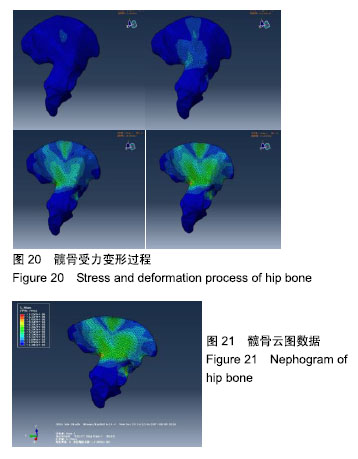
.jpg)
.jpg)
.jpg)
.jpg)
.jpg)
.jpg)
.jpg)






.jpg) 文题释义:
文题释义: